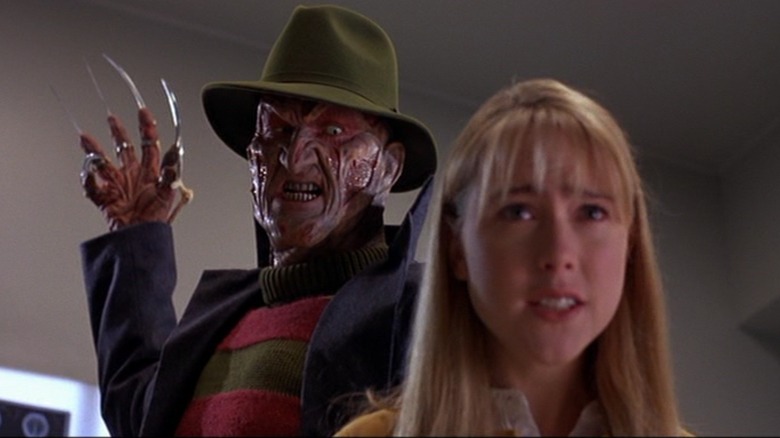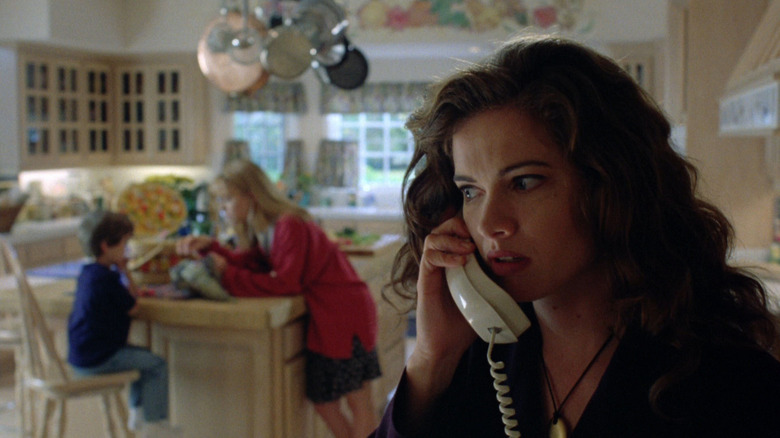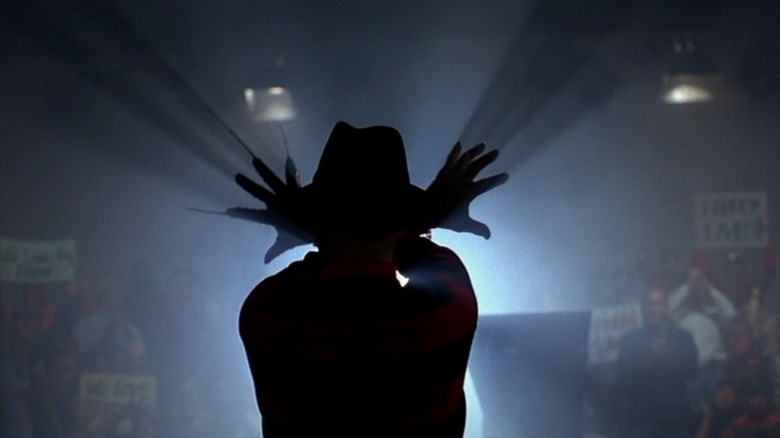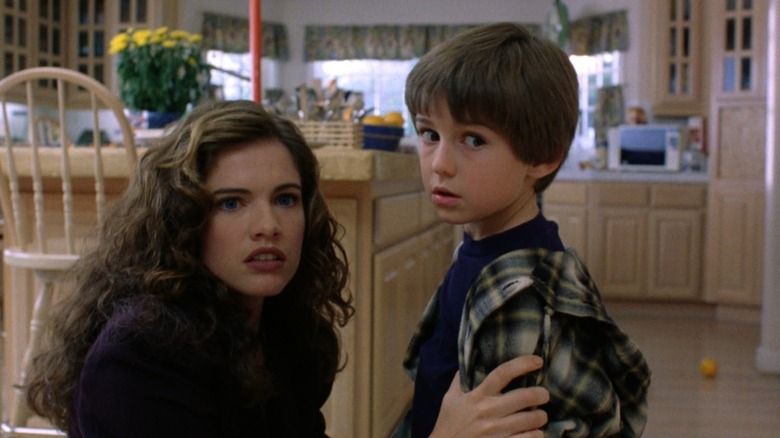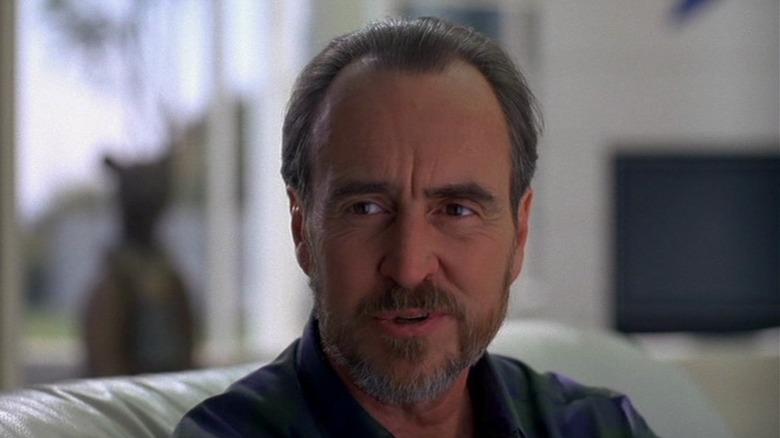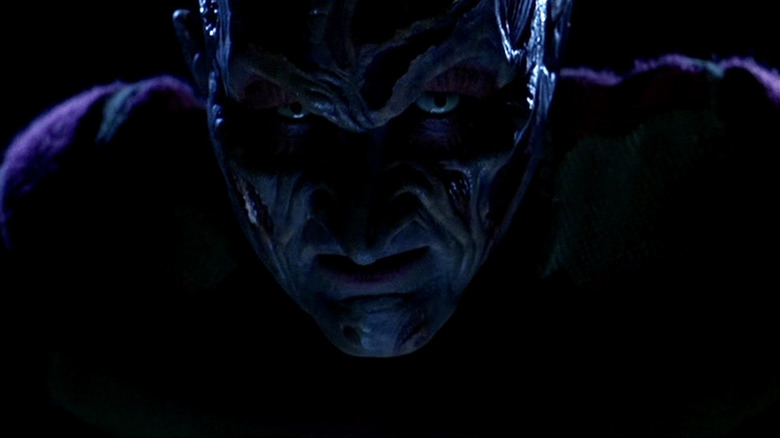The Daily Stream: Wes Craven's New Nightmare Brought The Horror Genre To A Meta Crossroads
(Welcome to The Daily Stream, an ongoing series in which the /Film team shares what they've been watching, why it's worth checking out, and where you can stream it.)
The Movie: "Wes Craven's New Nightmare"
Where You Can Stream It: AMC+
The Pitch: "Let me cut to the chase. How would you like to join us in the definitive 'Nightmare?'" This is how producer Bob Shaye pitches "Wes Craven's New Nightmare" to Heather Langenkamp, star of "A Nightmare on Elm Street," the original Freddy Krueger movie.
Unbeknownst to her, she's already in the movie; we're watching it and Craven is writing it even as she lives it onscreen. At this point, the "Nightmare" series is five sequels deep and Freddy's dead. They've killed him off, but fans are clamoring for more of him. Referring to Craven, Shaye says, "Who better to resurrect Freddy than his creator?"
Why It's Essential Viewing
The release of a trailer for the new "Scream" this month has had people abuzz about that franchise, and of course, since it's Halloween season, it's the perfect time for The Daily Stream to become The Daily Scream. ("What's your favorite scary movie?" asks Ghostface, the ultimate toxic fan, in that constipated phone voice of his.) Yet as much as "Scream" — which Craven also directed — gets credit for its meta deconstruction of slasher tropes, it's really a continuation of the deconstruction that he began two years earlier with "Wes Craven's New Nightmare."
In "New Nightmare," Craven was working with his own script and his own creation, Freddy, whereas "Scream" saw him tackling a script by up-and-coming screenwriter Kevin Williamson. It's "New Nightmare" that serves as the real bridge between the slasher franchises of the '70s and '80s and those of the '90s and 21st century.
The Legend of Freddy Krueger
In elementary school, I remember hearing about Freddy Krueger before ever seeing him ... which is the same experience you'll have watching "New Nightmare." For me as a kid, Freddy and slasher movies in general were urban legends, shared on the playground by friends whose parents were more permissive toward their impressionable young minds absorbing such content. I could only nod along and pretend to know what they were talking about as they referenced certain scenes.
My own parents tried to shield me from such things, but over time, I subsumed their iconography through bits of pop culture as random as The Great Movie Ride at Disney World. Freddy made an appearance during the highlight reel at the end of the ride. His fedora hat, his burned face, his striped sweater, and most of all, the bladed glove on his hand, loomed large in the public imagination — even for those of us who had never seen "A Nightmare on Elm Street" or any of its sequels.
As Langenkamp, herself says in "New Nightmare," "Every kid knows who Freddy is. He's like Santa Claus." This Satanic Santa even dresses in Christmas colors: red and green.
This all goes to say that "New Nightmare" might actually be the first Freddy Krueger movie I ever saw. In a way, that may have left me uniquely primed for its slow drip of Freddy as folklore. The premise involves Freddy crossing over "out of films, into our reality." Craven, Langenkamp, Shaye, and their fellow franchise veterans Robert Englund and John Saxon all play themselves. Englund makes his first surprise appearance while Langenkamp is guesting on a talk show; he hams it up for the crowd, which is filled with fans in Freddy costumes.
The Power of the Glove
In "New Nightmare," Langenkamp's limo driver recognizes her from the movies. He comments, "The first was the best," and this is reechoed in the unlucky 13-minute intro to "Scream," where Drew Barrymore's character says of Freddy's films: "The first one was [scary], but the rest sucked."
You can probably trace a line from that moment to modern blockbusters, with superheroes like the X-Men quipping, "At least we can all agree, the third one's always the worst." Clearly, those mutants never bothered to see "A Nightmare on Elm Street 3: Dream Warriors."
Miko Hughes, one of the scariest movie children, plays Langenkamp's son in "New Nightmare." He's a little kid who asks big questions, like "Why does God let there be bad things?" And he's not the kind of kid you want to leave alone in the kitchen, because he's liable to come at you with knives taped to his fingers like Freddy.
Then again, maybe that's just a dream, or a dream within a dream, or a movie within a movie. You never know what's real in "New Nightmare." The movie cuts from the dialogue its characters are speaking to those same lines of dialogue on Craven's computer. It withholds the sight of Freddy yet understands the power of his glove, which sometimes moves of its own animatronic volition, skittering across the table or scrambling up someone's chest and ripping them to bloody shreds.
Langenkamp's waking world is rocked by earthquakes. Tremors shake the swimming pool like a water glass and Freddy's fingers leave slash marks on her son's stuffed T-Rex. "Jurassic Park" has nothing on this dream monster, nor does the knife-wielding Ghostface (who could easily be subdued with martial arts or a gun, if you think about it).
Reckoning with Legacy
"New Nightmare" certainly wasn't the first meta-horror movie. The music video for Michael Jackson's "Thriller" debuted in 1983, the year before "A Nightmare on Elm Street," while "Fright Night" and "Jason Lives" came out in 1985 and 1986. There are plenty of other examples that predate those, like the 1968 Boris Karloff film, "Targets." However, "New Nightmare" delivered a high-profile, self-aware shot in the arm to one of horror's best-known icons right as the slasher sub-genre was petering out in some ostensibly "final" entries in the early 1990s.
1991 brought "Freddy's Dead: The Final Nightmare" and 1993 gave us "Jason Goes to Hell: The Final Friday." Along came "New Nightmare" the following October (Freddy's 10-year anniversary) to reckon with legacy and fan culture: something that has become a whole cottage industry online. "Scream" would elaborate on this with a movie trivia game where the stakes were life-or-death, as the Ghostface killer(s) put their victims in a situation where only film knowledge could save their lives.
"New Nightmare" shares a definite symbiosis with "Scream," and you can almost see where it was a testing ground for certain ideas. Before Ghostface ever harassed Barrymore's home-alone blonde, "New Nightmare" drew from Langenkamp's own experience being stalked by an obsessive fan. It had the voice of Freddy terrorizing the fictionalized version of her over the phone.
In the new millennium, we've seen plenty of film franchises strip themselves for parts and attempt to reassemble and repackage themselves as a new product, all the while asking us to believe in the same old illusion. "New Nightmare" recognizes that the audience knows this particular movie-magic act, the Freddy Krueger show, by heart, so it instead meets us halfway on our own turf, the real world.
An Ancient Evil
In "New Nightmare," Craven speaks of Freddy as an ancient entity, "a nightmare in progress ... captured by storytellers." Freddy's never scarier than he is in the hospital, where he appears in a black trenchcoat, reenacting his first onscreen kill by dragging the babysitter up the wall and onto the ceiling.
Craven's contemporary, John Carpenter, provided his own meta answer to "New Nightmare" in 1995 with "In the Mouth of Madness." Though it came another fifteen years after that, James Wan's "Insidious" re-utilized scream queen Lin Shaye. Its whole third-act dip into the astral plane furthermore owes a debt to Langenkamp's rescue mission to save her son in the dream realm at the end of "New Nightmare." Speaking of Wan, in "Scream," Ghostface says, "I want to play a game," which would become Jigsaw's tagline in the "Saw" franchise.
After "New Nightmare," there was nowhere left to go, really, for the Freddy Krueger movie series except the gimmickry of crossovers ("Freddy vs. Jason") and reboots (the 2010 "A Nightmare on Elm Street" starring Jackie Earle Haley). A better epilogue for Englund would be his Dr. Loomis-esque role in "Behind the Mask: The Rise of Leslie Vernon," which dictated its own set of narrative rules, similar to Randy, the Tarantinoesque video store clerk in "Scream" — only for it to ingeniously subvert those rules in its last act.
"Wes Craven's New Nightmare" bookended a decade of Freddy with the quintessential meta-horror deconstruction of an existing franchise. Yet even as he put one slasher icon to bed, Craven was gearing up to create another and to launch a new franchise, "Scream," which would bring horror kicking, and, well, screaming into the 21st century. Together, they mapped the meta-horror landscape for years to come.
